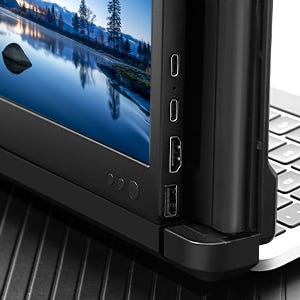Is it worth it to buy a portable monitor? This is the common question most people will ask these days. A portable monitor for laptop has gained popularity as a convenient way to work while on the go. They offer numerous advantages to various individuals, including business professionals, students, and gamers. However, with the abundance of portable monitor models available, selecting the most suitable one can be challenging. This article aims to help you dig into all of the benefits of portable monitors and guide you in choosing the right one for your needs!
Is it worth investing in portable monitors?
Certainly, portable laptop monitors are a valuable investment for individuals who require multiple screens but lack the room or inclination to establish a conventional multi-monitor arrangement. Additionally, if you seek to expand your screen real estate without compromising on portability and convenience, portable monitors for laptops are a great option to enhance your productivity.
-
Pros of using portable monitors:
1. Increased productivity: This is probably the number one reason people purchase the best portable monitor for laptop. Limited screen space can make it challenging to keep track of multiple applications or windows open, leading to time wasted on task switching. However, with a multi-screen display, users can save a significant amount of time.
2. Easy to set up: Most portable monitors come with a single cable that connects to your laptop via USB-C or HDMI, which means there are no drivers to install and no software to configure.
3. Improved portability: Portable laptop monitors are lightweight and easy to carry. You won’t have to worry about bulky equipment when you’re working or on the go. Additionally, they are available in a variety of sizes, ensuring that there is one that suits your requirements.
4. Wide compatibility: In addition to connecting the portable monitor to your laptop, it is also possible to connect it to other devices such as your mobile phone, Switch, PS5, and more. Utilizing the Type-C port, a portable monitor can provide a full-sized experience from even your smallest devices.
5. High resolution: With a resolution of FHD 1920*1080P, the majority of portable monitors offer clear and sharp images that are ideal for activities such as spreadsheet work or movie viewing.

-
Cons of using portable monitors:
1. Price: One of the most common complaints is that they are often considered more costly than conventional portable devices, typically priced between $199 and $500.
2. Power: Another potential downside is that some portable displays require extra power to function, which may be inconvenient if you are on the go without access to an electrical outlet.
The Best Portable Monitor Features (for You)
-
Size: When choosing a portable laptop monitor, it’s important to consider its size based on your specific needs. For instance, if you’re looking for a second screen for your kids to use in the car, a smaller and more portable monitor might be a better fit. On the other hand, if you’re editing photos or videos away from your desk, a larger monitor with higher display quality might be more suitable.
-
Resolution: If your purpose is to watch Netflix or have spontaneous one-on-one meetings, a 4K resolution may not be necessary. However, if you intend to work on tasks that involve going through extensive lines of code or editing media, then it is advisable to opt for a portable monitor with a high-resolution IPS display.
-
Compatibility: It’s important to verify the compatibility of the portable external display you’re interested in with your laptop or smartphone by checking its specifications online before making a purchase. Keep in mind that many portable monitors utilize the newer USB-C connector, which has gained popularity among laptops and smartphones.
- Portability: In addition to these features, it’s important to take into account the actual portability of the monitor you select. For instance, the CopGain P1M model boasts a built-in Type-C cable that allows for direct connection to your MacBook without any extra cables required. Moreover, the monitor’s shell is designed to provide support, eliminating the need for stand adjustments.

Are portable monitors compatible with all laptops?
While portable laptop monitors are generally compatible with most laptops, it’s important to note that not all laptops will work with all portable monitors. It’s essential to ensure that the ports on your laptop or phone match the ports on the portable monitor. For example, if the portable monitor features a USB-C port, your laptop must have one too to connect properly.
Most portable monitors typically offer support for USB-C (USB Type-C) and USB-A as well as HDMI (or mini HDMI) port connections. Nowadays, USB-C is the preferred and most straightforward way to connect.

Final Thoughts
Is investing in a portable monitor worthwhile? Definitely! Whether you are a frequent traveler for work or just need extra screen space to enhance productivity, a portable external monitor is a great investment. If you are in the market for a portable monitor, consider checking out Best Portable Monitor For Laptop — it’s a great choice that won’t disappoint you.



Leave a comment
This site is protected by hCaptcha and the hCaptcha Privacy Policy and Terms of Service apply.